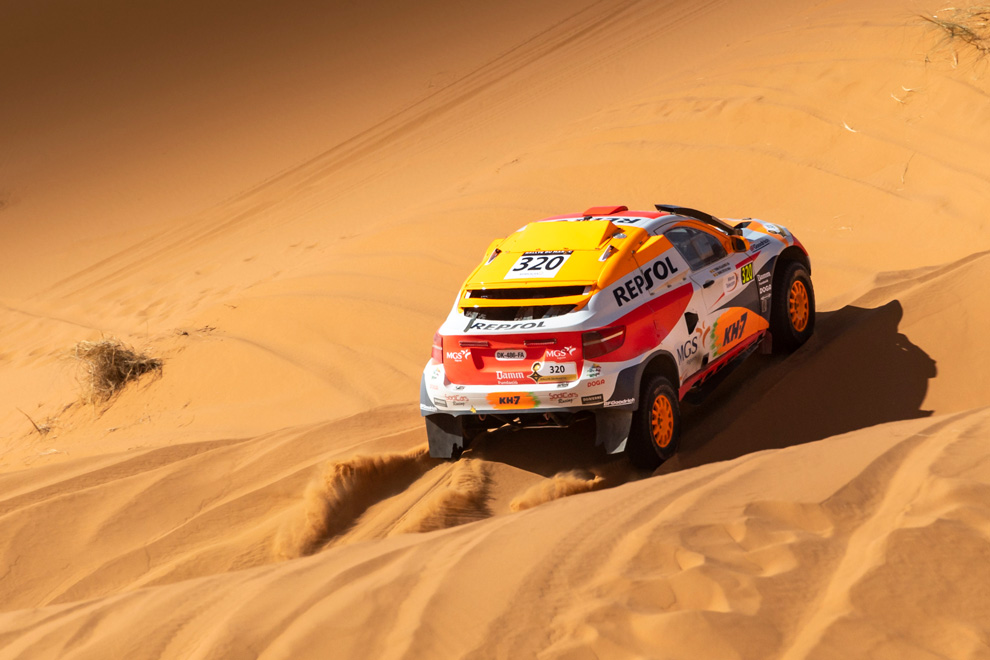We will be travelling to new lands, in this case Saudi Arabia, the thirtieth country to host at least a part of this event. This time, the route is completely within the borders of a single country.
Saudi Arabia is located in the Arabian Peninsula. It is the largest country in the Middle East and the 13th largest in the world, measuring 2 149 692 km2. Despite its size, almost one-fourth of the country is unpopulated. The majority of its surface is deserted and sand storms are common. It is home to five UNESCO World Heritage sites, one of which is Mecca, where millions of Muslims pilgrims travel annually.
The Dakar will take place in January, when temperatures exceed 30°C in the daytime and fall below 0°C at night. These conditions will be difficult on the engines.
This year, the rule changes include a new roadboook. It will now include a colour code and, in some stages, will only be handed to participants moments before setting off.


Day 1 – 05/01/20. Participants will depart due north from Jeddah to Al Wajh. This first stage of over 750 km will include a 320 km timed section, which will stretch almost parallel to the Red Sea. The vehicles will drive over the first dunes and rocky terrain of the rally, with speed and turns taking the spotlight.
Day 2 – 06/01/20. The route will continue from Al Wajh to the north towards Neom. This stage will be one of the rally’s shortest with just over 400 km, 367 km of which will be an SS. The multitude of tracks will come as a relief to the drivers, but the possibility of getting confused will make navigation and reference points vital to avoid wasting precious time.
Day 3 – 07/01/20. This will be a special loop beginning and ending in Neom, totalling 489 km (404 timed). The race will take place close to the Jordanian border, where the mountainous region will require meticulous navigation skills to avoid getting lost in the shade of the 2500 m tall Mt. Jabal al-Lawz (mountain of almonds). The highest point in this year’s rally, 1500 m, will be reached during this event.
Day 4 – 08/01/20. Starting at Neom, the Dakar will change direction to head south-east towards Al Ula. The valleys will be left behind to reach the sands of the rocky desert tracks. Once again, navigation will be crucial to avoid getting lost among the existing track. This stage will be 650 km long, 453 km of which will make up the special stage.





Day 5 – 09/01/20. This 563-km stage with 353 timed kilometres will begin in Al Ula a Ha’il. The rally will continue due east along the sandy and rocky trail. These huge rocks will serve as valuable reference points to avoid getting lost among the dunes – although the greatest danger is the possibility of getting stuck due to the sparse flora.
Day 6 – 10/01/20. 830 km, with a special of 478 km. With the rest day just around the corner, this stage will begin in Ha’il and take competitors to the country’s capital city Riyadh, which will be no mean feat. This long stage will turn south and take place in a completely off-track environment, where the only thing participants will see is sand, sand, and more sand. Those who are experienced in this type of terrain may have the advantage of making it to their well-deserved rest in good shape.
Rest day 11/01/20. Saudi Arabia’s capital Riyadh, whose name means “the gardens,” used to be an area with large vegetable gardens. Nowadays, it measures 1500 km2, hosts almost once fourth of the country’s population, and is full of skyscrapers, gardens, and innovative architectural designs.
Day 8 – 13/01/20. Starting from Wadi Al-Dawasir, this is a 713-km loop stage with a special of 474 km. The route will begin in the mountainous areas of the south to return to the starting point after having raced through canyons, slopes, and high-contrast areas. This stage will include an enormous 40 km track in a straight line, where the participants will release the power of their vehicles, while also keeping in mind that the mechanics must be preserved for what lies ahead.





Day 9 – 14/01/20. Wadi Al-Dawasir to Haradh, 713 km with a 474-km special. The pilots will face a long track of hard and broken soil, where any driving flaws will be paid dearly. Although the navigation will be easier, just as throughout the entire Dakar, the competitors can’t take their eye off the ball if they want to make it to the finish line on time.
Day 10 – 15/01/20. Haradh to Shubaytah, 608 km, with a special of 534 km. This will be the marathon stage, where participants will have to manage their resources well and be careful with the engine. It will not be easy. This stage will take place off-track through broken terrain and finish close to night-time with a long, 30 km trail over the dunes. Since it is a marathon stage, only the drivers and their partners can fix their vehicles.
Day 11 – 16/01/2020. Shubaytah to Haradh, 744 km with a special of 379 km. The beginning of this stage will delight the participants with an 80-km route through the country’s most beautiful dunes in full daylight. Some of this region’s dunes are over 200 m high, which is a challenge when it comes to ascending and descending safely.
Day 12 – 17/01/20. Haradh a Qiddiya. 447 km with a special of 374 km. Qiddiya, the finish line, is a city that is under construction close to Riyadh. The participants will be anxious to finally relax and leave behind the pressure of tending to potential mechanical issues. Navigation between tracks will become a challenge for the co-drivers, who will have to keep track of as many reference points as possible.


 Join Us
Join Us  Join Us
Join Us 